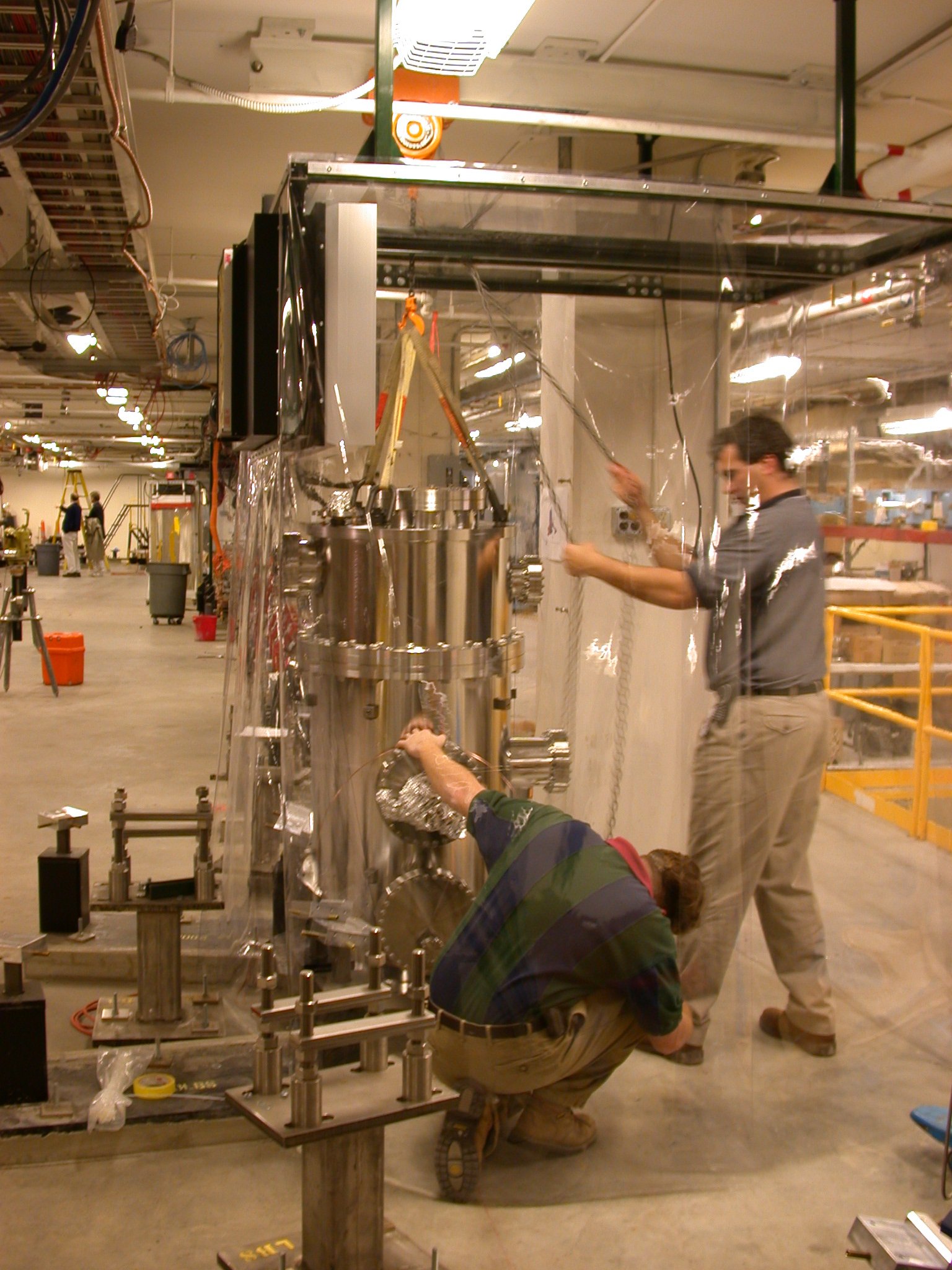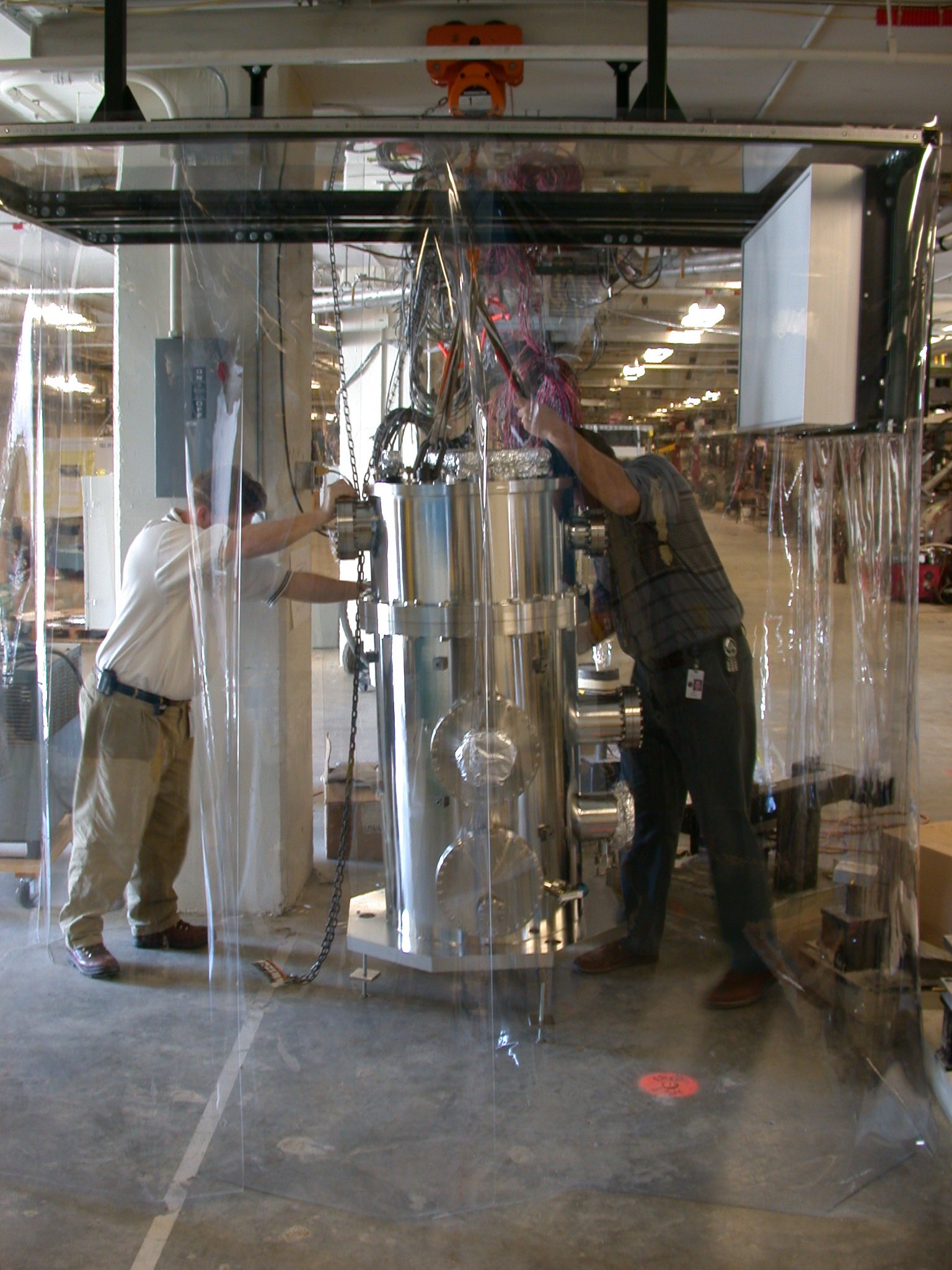

November 11-15, 2002
(1) all four of the large dipole magnets (GW’s) for the first optical chicane were qualified by the magnetic measurement crew, found to meet our demanding specifications (1/1000), and released for installation. Two have been installed and the second two will be installed next week; (2) we have identified several unique work-arounds for the late delivery of the recirculation hardware that allows our commissioning schedule to proceed (see WBS 9 write-up); with these work-arounds all beam transport for the first arc is now on site and being qualified for installation; (3) the optical cavity vacuum assemblies were installed in the final positions fore and aft of the wiggler; the High Voltage Power Supply tank for the electron gun was successfully pressure tested for operation.
Today an article was published in Nature by Gwyn Williams et al that describes our successful measurement and analysis of the high power (20 watt) , short pulse, terahertz radiation with IR Demo last year just before we shut down the device for FEL Upgrade installation.
The article is available at:
http://www.nature.com/cgitaf/DynaPage.taf?file=/nature/journal/v420/n6912/full/nature01175_fs.html&content_filetype=pdf
and an accompanying "News and Views" story is available at:
http://www.nature.com/cgi-taf/DynaPage.taf?file=/nature/journal/v420/n6912/full/420131a_fs
Management:
Effort was spent this week to analyze and document the FEL commissioning
technical and cost status for presentation to Gil Graff at the ONR Program
Office. Several scenarios were presented that prioritized FY03 FEL Upgrade
activities with respect to potential FY03 funding levels. These scenarios
will be reviewed at next week’s FEL Upgrade Semiannual Review for the review
committee’s review and comment. We appreciate the time that was devoted
to this task by Gil Graf at ONR and Wayne Skinner at our DOE Site Office.
The next Semiannual Project Review is next week on Wed. and Thurs., November 20-21. WBS managers spent some time this week in between their installation, check-out and commissioning activities making preparations for the review. We are all looking forward to showing off the new machine next week to our review committee.
George Neil and Steve Benson gave several presentations on the status of the FEL Upgrade program and scaling to higher power FEL systems at this week’s Directed Energy Professional Society Symposium hosted by NAVSEA and the Naval Postgraduate School at Monterey, CA.
FELs had very high visibility at the DEPS conference and in addition to George and Steve's papers, FEL Dept. members were listed as co-authors on three AES papers and two NPS papers.
WBS 3 (Beam Physics):
Results for various magnet measurements have been reviewed and the
magnet’s performance certified.
Tune-up procedures are being simulated so as to provide final dump line layout specifications. An amusing result has emerged: Conservation of energy limits the amount of energy you can recover. (Corollary: If the bunch length is longer than 360 degrees, you can't recover it very well...!)
WBS 4 (Injector):
The door operating bellows flange was removed from the gun and successfully
welded. The gun was pumped down, all ion pumps started and a satisfactory
leak check was accomplished. A small amount of contamination was discovered
in the gun and injector line and a hot N2 purge is being planned to remove
the bulk of it prior to the bake. The extractor cart was removed from the
ceramic stack and the corona rings and support rods were fit up. The SF6
tank is being readied for fit up with the high voltage tank so we can mark
the operating probe position and complete fabrication of the resistor.
Gun HVPS - The Conditioning Resistor assembly is together and will be positioned to mark the location for its probe connector. The connector will then be welded into the aluminum shell. The HVPS Tank was also leak tested and passed this week.
WBS 6 (RF):
Quarter HVPS - The wiring for Unit #4 HVPS is complete and will be
tested for PSS Certification noon today. The klystron cart is wired, but
still lacks some LCW fittings. These fittings are on order. The software
appears to be working fine in all aspects. The RF systems will be connected
to the Quarter cavities early next week for SRF testing.
Zone 2 - Complete and operational. SRF tested to its Drive High values without problems.
Zone 4 - Installation is complete. SRF has tested the zone, but not yet to its Drive High values. They will check the cavity Q's and download files as the klystrons forward power seem more than adequate to produce the Drive High gradients. It will be checked again early next week.
WBS 8 (Instrumentation):
Drive Laser Controls - The acromag card is fully implemented into iocfel10
and all functions (Digital-I/O, ADC & DAC channels) are fully checked-out.
The difficulty in bringing this card online was due to an oversight on
our part in properly configuring the VME backplane to handle the interrupts
(a lesson we won't soon forget). As a result, we now know why we had so
much trouble with the OMS stepper-motor controller. Having resolved all
our hardware issues with these two plug-in modules, their respective control
elements (water pump, remote key status, shutter control, EO Cell bias
control, SHG readback and remote/variable attenuation are all online. We
are eager to log some operation time on these items now.
Drive Laser Pulse Controller (DLPC) Upgrade - The SSMC-RF connectors for the CO305 VME Module came in sooner than expected and so the board is being finished for testing next week. Also, as part of the DLPC upgrade, a full system print of the drive laser as a sub-system is being produced. This will document everything in the drive laser clean room from an as-built/controls perspective. With the basic connectivity of the drive laser's RF controls documented including the custom modifications to the Modelocker chassis, we are in a good position to lock-in the design of the automatic switch to internal RF as a part of the external RF interlock upgrade. This control function prevents the possibility of a "Q-Switch" and cooking the Second Harmonic Generation (SHG) crystal. The modified Modelocker chassis with the manual RF switch is this weeks picture link at: http://laser.jlab.org/wbs8/
Beam Loss Monitors (BLMs) - The F0151 module has been pulled from iocfel8 and given to EES as a the functional prototype to aid in the assembly of the rest of the boards. We will get it back as they finish new boards one at a time versus assembling the lot in parallel.
The new beam viewer design is complete and being manufactured (THANKS Casy!). This design is a 1"x4" silicon paddle fixed to a 6" conflat blank. The paddle has registration marks at 5mm with a major mark on center. There are two of these being built one for the strait ahead spectrometer and the second for the GW beam diverter downstream of the wiggler. All parts are on order for the Synchrotron Light Monitor (SLM) attenuators. This is a very simple design based on 2"x4" box aluminum beam. Assembly of the prototype should take place next week.
The old OPCHIC DC power supply has been reinstalled for powering the DW & DY (work around). It was moved into place and had its AC power connected. The FEL I&C team has wired into the PSS (they are much to busy) to enable certification next week during the scheduled PSS certification of the 1/4CM HPA. This is the LAST PSS connected power supply. The software group has begun work on the software and screens to support the old OPCHIC power supply. DC power to the 0F region corrector magnets is near completion. The new GW does not require a PSS connection since it has the leads covered and is only a 5 kW supply.
Those (2ga) leads will be run in next week. The optical cavity wiring (controls) is progressing, much of this activity is done after 1700 and must be coordinated with the (nearly) nightly lockups for RF commissioning. The control screen for the 4 channel BPMs are being worked, much of the hardware will be checked out next week.
Beamviewers for the wiggler have been installed and checkout is in progress. The 25 pin MPS breakout modules have been received from the vendor and are being populated in house. Beamviewer MPS cables were pulled into FL02B10 and termination is in progress. Work progressed on the BLM high voltage cable terminations.
Schematic capture for the HV Interlock digital I/O board have been received from EECAD and under review. Work has progressed on the system print for the HV interlock. The software for the Machine Protection System (MPS) is progressing very well. There are some screens done with the new cards all reading back. Many of the input cables are complete and ready to connect, this will be done as priorities allow.
WBS 9 (Transport):
Work Arounds - Work arounds are now implemented to compensate for the
recirculation magnets that are late while maintaining the commissioning
schedule. Dave Douglas has blessed all these efforts as worthy of pursuit.
2. For first light commissioning using pulsed beam, mid January, use an IR Demo 180° Dipole (DY) to turn the first arc (along with the GQ and the GX dipoles that will be measured by then). Fortunately DY is rated for 80 MeV/c (the commissioning momentum) and its 2 inch aperture is adequate for the requirements of the first arc. The DY only needs new flanges on its chamber to adapt to the GQ-GX chambers.
4. Since the Sextupoles are designed but not procured, work around using
IR Demo SC Sextupoles. We are expanding them with shim blocks and pole
shifts to fit over larger chamber and they are just strong enough for the
commissioning energy of 80 MeV if we double their current and cool
WBS 11 (Optics):
The titles of the attached pictures are the best descriptors.
 |
 |
|
|
|
This week's activities culminated with our transporting the optical cavity vacuum vessels to the FEL vault. The support girders with ultraviewers attached, were installed next to their vacuum vessels and aligned by the Survey and Alignment team. A number of incremental milestones, were accomplished to do this, the major ones are listed below:
Working with Survey and Alignment, the internal optical components for both the HR and OC assemblies were fiducialized in the vacuum vessels. We then translated the mirrors for both assemblies, and checked the repeatability. The data reflected the repeatability of the portable CMM, ~ 100 microns. That is our specification. There is evidence that the performance is higher. The HR vacuum vessel, with internal hardware for vertical motion, was leak checked, and checked for oil contamination. It passed both tests. Clean enclosures were established for both the HR and OC assemblies before they were moved.
During the above, we also completed inspection of the first light outcouplers. One failed (visible flaws within 80% CA) but the other passed. We also began installing one of the two alignment HeNe lasers we'll use for our alignment activities.
The custom optical breadboards for the OCMMS optics arrived. Drawings for the insertable mirror used to route high power beam to the diagnostic beam dump are being checked. The vacuum vessels for the high power optical transport are in Procurement.
We discovered that some components for the THz diagnostic still had oil contamination. The components were disassembled, recleaned, and are being baked before they are reassembled.